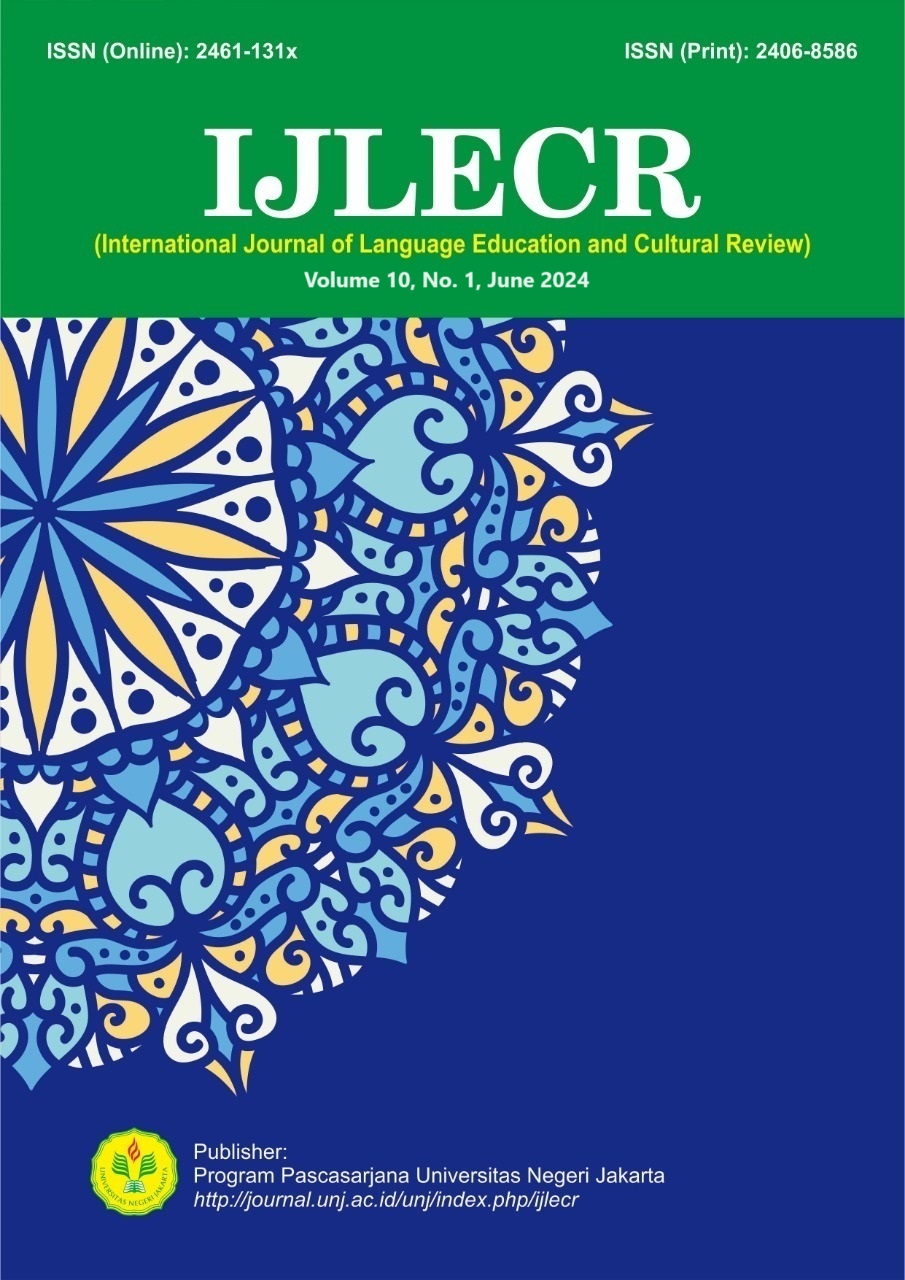Student’s Perception Towards the Use of DeepL Translator in Writing Thesis or Journal for English Education Students
DOI:
https://doi.org/10.21009/ijlecr.v10i1.47937Keywords:
Student’s Perception, DeepL Translator, Writing Thesis, Journal, English Education StudentsAbstract
Translation is a crucial aspect for non-native English students, especially when writing academic theses or journals. This study aims to discuss the use of the DeepL Translator application in writing a thesis or journal of English students. This research employs qualitative methods with a case analysis design by analyzing data derived from questionnaire data and deeper interviews related to the use of DeepL Translator. The use of questionnaire data and further interviews were conducted with 24 final semester English students. The data were analyzed using Miles and Huberman's techniques, which include data reduction, data presentation, data display, and drawing conclusions to evaluate the effectiveness of the DeepL Translator. The results of this study show that students use DeepL translators a lot when making their theses or journals. By using the method of translating per paragraph, students complete their thesis or journal using DeepL Translator to convert Indonesian into English. The reason they use this application is because the results of this translation are more accurate and effective than those of other translation machines and also the students agree that they are often use this DeepL Translator to write their thesis or journal.
References
Bolshakov, I., & Gelbukh, A. (2004). Computational linguistics models, resources, applications. Mexico: Serie Ciencia de la Computación.
Brown, K. (2016). Critical account of English syntax: Grammar, meaning, text. Skotlandia: Edinburgh University Press.
Danping, D. (2023). The use of machine translation among Chinese students. SHS Web of Conferences, 168, 1-8. https://doi.org/10.1051/shsconf/202316803028
Dworkin, S. L. (2009). Sample size policy for qualitative studies using in-depth interviews. Archives of Sexual Behavior, 38(6). https://pubmed.ncbi.nlm.nih.gov/22968493/
Ellis, R. (2018). Reflections on task-based language teaching. Multilingual Matters. https://doi.org/10.21832/9781788920148
Fabbro, F., & Pavesi, M. (2016). Translation tools and student writing: Accuracy versus assistance. Journal of Educational Technology Studies, 9(1), 45-59.
Harahap, S. H., & Kembaren, F. R. W. (2023). Teachers’ perceptions of utilizing Quizizz application in ELT for young learners. Scope: Journal of English Language Teaching, 7(2), 278-286. http://dx.doi.org/10.30998/scope.v7i2.16224
Huang, X., Zhang, Y., & Lee, A. (2022). Accuracy in machine translation: A study of DeepL Translator. Journal of Language Technology, 18(2), 75-89.
Hutchins, W. J. (1995). Machine translation: A brief history. In E. F. K. W. S. (Ed.). Concise history of the language sciences (pp. 431-445). Pergamon. https://doi.org/10.1016/B978-0-08-042580-1.50066-0
Hutchins, J., & Somers, H. (1992). An Introduction to machine translation. London: Academic Press Limited..
Isnayanti, L. (2023). The students’ perception of using Google Translate in writing an English text at the eleventh grade of SMAN 4 Jember. Journal of Language Education and Research, 12(3), 45-59.
Iswara, N. (2024). The rise of machine translation in academic settings. Journal of Language Technology and Innovation, 10(2), 55-67. https://doi.org/10.1234/jlti.2024.055
Kembaren, F. R. W. (2018). An analysis of translation techniques in the English versions of arrahman surah. International Journal on Language, Research and Education Studies (IJLRES), 2(1), 56-72. http://repository.uinsu.ac.id/id/eprint/5236
Kembaren, F. R. W. (2018). Translation theory and practice. http://repository.uinsu.ac.id/5251/7/translation%20theory%20and%20practice-1.pdf
Kembaren, F. R. W., Hasibuan, A. K., & Natasya, A. (2023). Technology trends in translation: A comparative analysis of machine and human translation. Absorbent Mind: Journal of Psychology and Child Development, 3(2), 169-183.
Krawczyk, J. (2018). Advancements in neural machine translation and their impact on academic writing. Machine Translation Journal, 32(3), 123-139
Kumar, R. (2024). Translation tools in a globalized world: A review of DeepL and its limitations. Translation Studies Review, 8(2), 112-127.
Lee, A., & Thompson, B. (2023). Contextual nuances in machine translation: Challenges and solutions. Journal of Translation Studies, 12(3), 145-160.
Lee, S. M., & Briggs, N. (2021). Effects of using machine translation to mediate the revision process of Korean university students’ academic writing. ReCALL, 33(1), 18-33. https://doi.org/10.1017/S0958344020000191
Malmkjær, K. (Ed.). (2018). The Routledge handbook of translation studies and linguistics. London: Routledge.
Merriam, S. B., & Tisdell, E. J. (2016). Qualitative research: A guide to design and implementation (4th ed.). San Francisco: Jossey-Bass.
Miles, M. B., & Huberman, A. M. (1994). Qualitative data analysis: An expanded sourcebook (2nd ed.). London: Sage Publications.
Muchtar, M., & Kembaren, F. R. W. (2019). Basic theory of translation. Retrieved from http://repository.uinsu.ac.id/5232/8/Basic%20Theory%20of%20Translation-1.pdf
Peregoy, S. F., Boyle, O. F., & Martinez, G. (2011). Reading, writing, and learning in ESL: A resource book for teaching K–12 English learners. Pearson Education. https://doi.org/10.5054/tj.2011.244400
Pym, A., Ayvazyan, N., & Prioleau, J. M. (2022). Should raw machine translation be used for public-health information? Suggestions for a multilingual communication policy in Catalonia. Just. Journal of Language Rights & Minorities, Revista de Drets Lingüístics i Minories, 1(1-2), 71-99. https://doi.org/10.7203/Just.1.24880.
Sidiq, F. A., & Syafryadin, S. (2024). Students’ perception of using DeepL for translating English text. ELTIN Journal: Journal of English Language Teaching in Indonesia, 12(1), 139-148.
Smith, J., & Jones, M. (2021). Enhancing writing with DeepL: Grammar correction and clarity in translations. Computational Linguistics Review, 14(1), 101-115.
Steigerwald, E., Ramírez-Castañeda, V., Brandt, D. Y., Báldi, A., Shapiro, J. T., Bowker, L., & Tarvin, R. D. (2022). BioScience, 72(10), 988-998. https://doi.org/10.1093/biosci/biac062
Sujarwo, J. (2020). Adaptation of translation methods among students: Needs-based approaches. Journal of Translation and Interpretation Studies, 6(1), 23-38.
Ugwu, C. N., & Eze, V. U. (2023). Qualitative research. IDOSR Journal of Computer and Applied Sciences, 12(2), 45-60. https://doi.org/10.5678/idjcas.2023.12.2.45
Varela-Salinas, M. J., & Burbat, R. (2018). Google Translate and DeepL: Breaking taboos in translator training. Journal of Translation Studies, 21(3), 45-59. https://hdl.handle.net/10630/16310
Wirantaka, A., & Fijanah, M. S. (2021, December). Effective use of Google Translate in writing. In Proceedings of the International Conference on Sustainable Innovation Track Humanities Education and Social Sciences (ICSIHESS 2021) (pp. 15-23). Atlantis Press. 10.2991/assehr.k.211227.003
Zuhairo, Z., & Kembaren, F. R. W. (2024). Intermediate students’ perceptions of the transformation of online translation engine. IJLECR (International Journal of Language Education and Cultural Review), 10(1), 12-20. https://doi.org/10.21009/ijlecr.v10i1.45004








